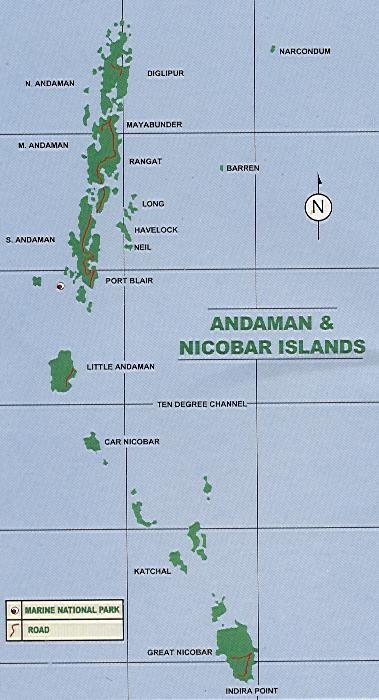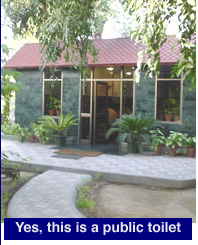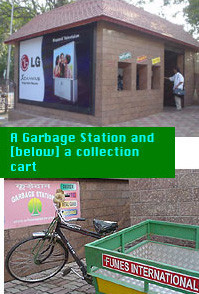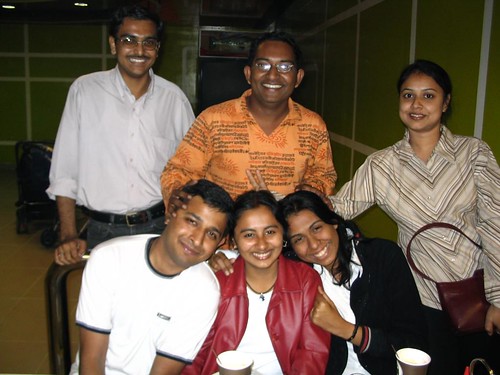Source : Dataquest India
THE HOT VERTICALS: The Great Indian Software Revolution
From $12 million in 1980 to $9 billion in 2002—this long journey took some stumbling around and a lot of grit. This is the story of Indian software, one that’s never been told this way before
The software industry has come a long way. And like all big events of history, it happened part by design and part my accident. In the 70s, not many people in India understood the word "software" and there was no separate software industry. Throughout the 70s, multinationals like IBM and ICL (UK) were the largest providers of hardware to the industry—and it came bundled with the operating systems and a few basic packages. Larger enterprises—including the Indian defense and public sectors—which needed customized applications, had their own large EDP teams that did everything from installing systems to writing software.In fact, when specific software applications began to get popular, stand alone boxes were made for them. Few will remember now but at the Manufacturer’s CSI Exhibition in 1983, there were 21 different "word processing machines" on display. The concept of a standalone word processing software did not exist. Later, when local companies bloomed after IBM’s exit, they too had their own proprietary operating systems—which ran a few of their own programs.
SW exports: All a question of forex
At the time, software exports as a concept was still way below the horizon. Though India was among the first developing nations to recognize the importance of software, the key concern then was foreign exchange.
The nub was this—if companies wanted to export software, it had to be written on and designed for systems that were standard worldwide. That meant the most recent IBM systems. But IBM in India was selling old, refurbished and antiquated machines. Software exporters, therefore, needed to import specific hardware to be able to write software they could export. DoE grudgingly allowed exports—on the condition that the exporters recover twice the value of the foreign exchange spent on importing computers within five years. Later, that was changed to an export commitment equal to the price of computers imported.
...But it wasn’t easy
In that climate, however, there were a few software companies that dared to set up shop. The first was Tata Consulting Services, in 1968. After a few local orders, TCS got its first big export assignment five years down the line. In 1973-74, it did a stores and inventory control software solution for an electricity generation unit in Iran. The same year, it developed a hospital information system in UK along with Burroughs Corporation, at that time the second-largest HW company in the world. These were the nebulous beginnings of the Indian SW industry.
The cost connection
Despite the tough policy environment, by 1981-82, India was the only developing nation to have any significant software exports—$12 million—a substantial leap over the 1979 level of $4.4 million. Though 30 companies were registered as software exporters (most operating out of the SEEPZ Mumbai), the two Tata companies—TCS and TBL—accounted for 67% of all exports.
The main USP for Indian companies at that time was cost. The cost of a developer in India varied from $17,000 to $25,000 annually. The cost of sending the same developer to the US came to about $32,000-42,000 per annum. Compare this with US developer rates of about $60,000-140,000 yearly—the cost proposition was clear.
There were significant challenges, though. The first was the lack of availability of hardware—importing systems was neither easy nor cheap. The second—a shortfall in trained manpower. Although the education system was churning out enough engineers, only a handful of colleges offered computer courses.
So there it was—a budding industry with a large array of problems. To deal with them, the first ad hoc committee of software exporters was formed on 23 April 1983, with industry stalwarts like Nirmal Jain of TCS, Lynette Saldhana of ICIM, Adi Cooper of Digitron and Prakash Hebalkar of TBL at the helm. Eventually, Nasscom would be formed as the industry’s representative body.
But in 1984, the software industry found its first and unexpected ally—the Toshiba laptop-toting Indian Prime Minister Rajeev Gandhi. Within 19 days of coming to power, he introduced the New Computer Policy that simplified import procedures for software and reduced software import duties from 100% to 60%. Locally, software was recognized as a separate industry, licensing procedures were simplified and access to foreign exchange for software firms made easier.
This was the decade of churn, marked by three distinct phenomena—India’s metamorphosis into a ‘Unix country’, the rise and fall of the local packaged software market, and the beginning of the outsourcing era.
The Unix revolution
In 1986, the Rangarajan Committee on the modernization of the banking sector (set up by the RBI) came out with its report. Among other things, it recommended standardizing banking systems on Unix, then an unperfected operating system compared to MS-DOS. The government floated a tender for 400 Unix systems and set off a scramble among Indian companies to come up with a Unix platform. Though the local part of the contract eventually went to Sunray Computers, the report led local vendors into the Unix arena and eventually saw India’s transformation into a ‘Unix country’.
But the transition was not smooth. There were three main issues. One, the lack of an existing base of trained manpower on Unix and C. Two, computing requirements in India had been limited to batch-oriented jobs, and as a result, the capability of Unix, which is essentially a multi-user OS, was not fully understood. And finally, importing Unix at source from AT&T was not easy. So each company came up with its own version—none of them worked too well. Add to it the fact that Unix systems were also far more expensive—and there was a real problem on hand.
Driven by the banking sector, policy changes in 1986 enabled the import of the Unix source code and by 1988, Unix was emerging as the de facto standard in the super micro and the mini markets. According to an IDC study, 1,400 Unix systems were shipped in 1987-88, compared to just 480 the year before—a whopping 191% growth.
Software packages:
The rise and fall
In 1986, other norms had also been eased. Anyone could import software now at a duty of 60%. Indian firms could become distributors of foreign packages. And SW EOUs could import hardware without duties. The rationale was that by "flooding in" software, Indian firms over a period of time would gain the competitiveness and ability to "flood out" software.
Meanwhile, the PC had come to India. Within a couple of years, a price war triggered by Sterling Computers led to vendors slashing prices. By 1988, there were more than 70,000 microcomputers in the market. The PC and compatibles market boomed—alongside, local SW packages grew.
By December 1988, more than 500 software companies were churning out packaged software—a major chunk of them cheap accounting packages. New Delhi-based AK Saxena Software Consultants sold a series of accounting packages called Khazanchi, Munimji, Naazirji and even Lalaithaji. Most of them were priced at around Rs 490 and were targeted at PC/XT/AT users of small and medium enterprises. At the higher end were companies like Wipro (Easyacc), TCS (Business Management Series), Softek (SIMS), Radix (Finman)—all priced between Rs 5,000 and Rs 10,000. Despite the burgeoning domestic packaged software market, Indian players initially lacked the funds and reputation to penetrate markets abroad.
Eventually though, the local software packages industry died a natural death, with a few exceptions like Tally and Fact—alive and well to this day. The package industry had thrived on the PC boom but was killed by the import of foreign packages. Meanwhile, communications technology was silently maturing in India and another era was set to begin.
The birth of outsourcing
Till now, the export of software had meant a physical transfer—either of the programmer himself (bodyshopping) or of software on floppies. The first glimmers of a change appeared in 1985, when TI set up an office in Bangalore with a direct satellite link to the US. In 1989, VSNL commissioned a direct 64-kbps satellite link to the US. It was a new gateway switching system which operated through Intelsat and was directly linked to AT&Ts earth station at Coram on the US East Coast. It offered software exporters a completely new way of functioning.
Around this time, US policy changes forced Indian SW exporters to look beyond the body-shopping model. In 1993, the US Immigration and Naturalization Service proposed changes to the regulation that made it difficult to get B-1 visas. The new H-1 visa required a certification from the US Department of Labor that prevailing market wages were being paid to immigrant workers.
Its direct impact—clients would have lesser incentive to hire software engineers from India. Also, Indian SW pros were brought under the ambit of the Immigration Act and had to pay social security taxes (amounting to 21%) to the US. Eventually, what came to pass was a watered-down H1B visa. But combined with the changes in communications technology, a new way of doing business was born in the SW export industry—a mix of onsite and offshore. Exports boomed, growing from $128 million in 1990-91 to $485 million in 1994-95. A new era had begun.
Boom time
The last half-a-decade of the Indian software industry can easily be called its ‘Golden Era’. For a change, just about everything that could go right, did. Surviving Indian software packages began to receive international attention—Infy’s Bancs 2000, TCS’ E-X and Ramco’s Marshall (endorsed by Bill Gates, no less) came to the fore. According to IBS rankings,
i-Flex’s MicroBanker was the topselling international banking solution in the world in 1995.
Year 1995 also marked the beginnings of Linux in India. PCQuest, the leading personal computing magazine, began giving out free Linux CDs in March 1995 to expose readers to "the other side of computing". By 1999, more than 70,000 CDs of Linux had been put out in the market and Indian Linux user groups were thriving on the Net. Then came the ERP boom. SAP, the worldwide ERP market leader, set up a 100% subsidiary—quickly, India became its fastest-growing market. In 1996, SAP was growing at 160%, with 40 customers in India. It forecast a growth of 150% for 1997.
And then, of course, was Y2K—the biggest bogey in software history that triggered off a chain of events. Exports grew on the strength of Y2K and never looked back. The local training industry boomed partially because of it. Aptech grew from 27 centers and a turnover of Rs 10 crore in 1991 to 850 centers and Rs 202 crore in March 1997. Locally, full-page government ads in leading dailies, asking companies to become ‘Y2K-compliant’, helped the paranoia along.
By the end of 1999, the industry was on an all-time high. IPOs of software companies were getting oversubscribed several times. Sonata was oversubscribed by over four times, KPIT 40 times, Satyam 19 times... This gave rise to a minor scandal that rose and fell—fly-by-night operators who often had no business at all started putting IT in their names and entering the IPO market. They made money; a lot of investors lost their’s.
Meanwhile, the venture capital phenomenon began to take off. According to figures released by the Indian Venture Capital Association, VC investments grew from Rs 70 crore in 1996-97 to Rs 2,162 crore in 1999-2000. A substantial amount of that investment in the last years went to dot-coms.
Getting closer to the bust
The bust? Or maybe not. This is recent history. By end-2000, the slowdown set in. The dot-com bubble burst. VCs began demanding sounder business models from start-ups, while earlier, they’d been willing to settle for an idea and a sparkle in the eye. Software exporters saw enterprise IT budgets slashed and RoI becoming key. They had hired in a frenzy in the boom times. By 2001 they were trying to fire quietly. For the first time, the industry witnessed lay-offs—and on a scale never witnessed before.
Going forward, there’ll be one word that will define the software export industry in the next few years—offshoring. At the moment, a good 60% of all software work happens onsite. It is more expensive for the client and offers thinner margins for the exporters. As a result, last year saw a greater push toward moving as much work as possible to India. At the same time, after the DoE allowed 100% FDI in the IT industry in 1999, a lot of MNCs set up development centers in India as their own offshore arms, most of them doing really high-end work.
This phenomenon and all the issues it generates in host countries will determine the shape of things to come in the next few years.
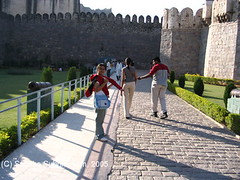 Stony path to the entrance
Stony path to the entrance
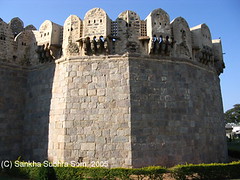 Full frontal
Full frontal
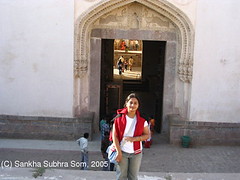 The entrance to the clapping portico
The entrance to the clapping portico
 Medieval morgue
Medieval morgue
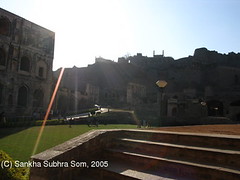 Sunlit interior
Sunlit interior
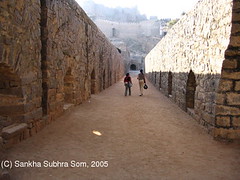 Barracks.
Barracks.
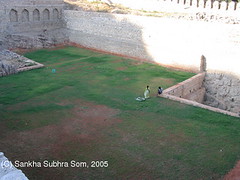 The largest of the three water tanks
The largest of the three water tanks
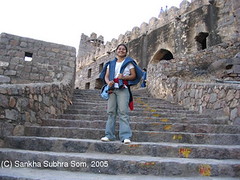 The steep climb
The steep climb
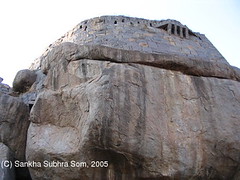 Vertical limit
Vertical limit
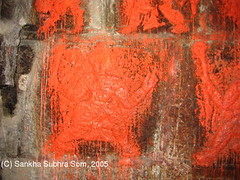 Sculpture by Ramdass, incarcerated in Golconda for 14 years.
Sculpture by Ramdass, incarcerated in Golconda for 14 years.
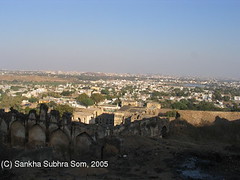 Panoramic view of city from the front.
Panoramic view of city from the front.
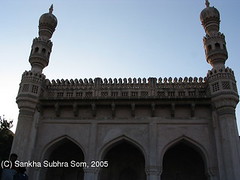 The people's mosque. Notice the fusion of Islamic and Hindu architecture.
The people's mosque. Notice the fusion of Islamic and Hindu architecture.
 The Kali temple. Probably the oldest piece of architecture (13th century)
The Kali temple. Probably the oldest piece of architecture (13th century)
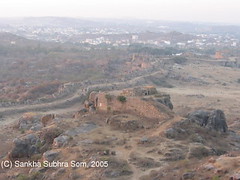 Panoramic view at the back
Panoramic view at the back
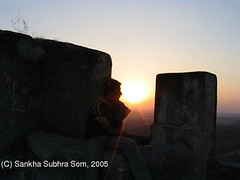 Sunset at Golconda.
Sunset at Golconda.
 The darbar(courtroom) at the top.
The darbar(courtroom) at the top.
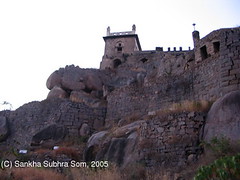 Going down, down, down.
Going down, down, down.
